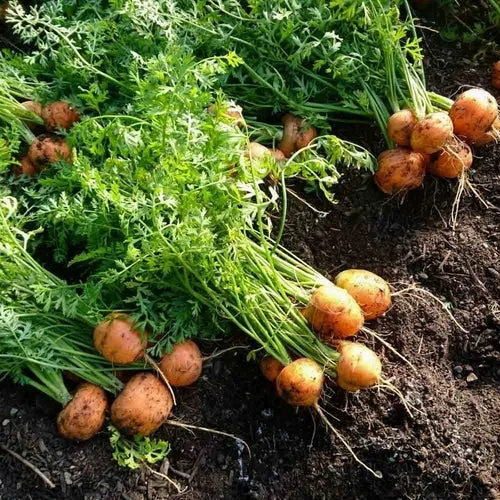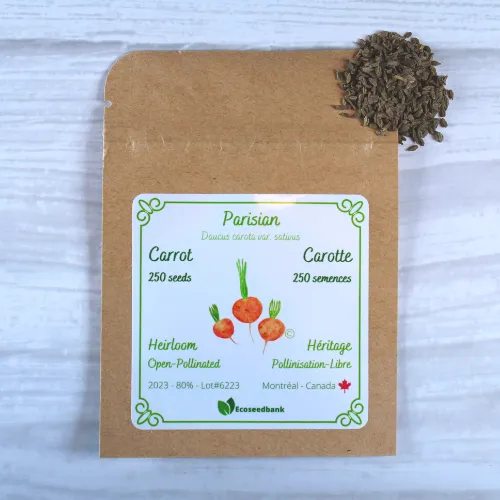Parisian carrots were developed in Paris, France, sometime during the early 1800s. The small round carrots grew steadily in popularity and were introduced to the United States in 1861, where they quickly became popular there as well. The exact origins of Parisian carrots are unknown, but it is thought to have been developed to fit within a window box, most likely in the densely populated city of Paris. To compensate for the lack of green spaces, Parisians grew a lot of vegetables, fruits and herbs in long shallow window boxes. Window boxes were used for food cultivation since at least ancient Roman times. Nowadays, window boxes are mostly ornamental, showcasing colourful flowers and exotic plants, but back then, they were used to complement a family’s food supply.
The Parisian carrot is a vegetable very well adapted to compact spaces and container gardening, especially when they are bunched together. Like other carrots, they grow well in sandy and loamy soils. What is unique about the Parisian carrots is that they are not bothered by rocky or heavy soils. This early season carrot is a very small variety, maturing from 2 to 5 cm in diameter with a globe-like shape, almost like a radish. The bright green tops grow to only 20-25 cm tall and they are edible as well. This rare heirloom carrot is well-liked by gourmet chefs, as it can be used whole in the cooking, giving a more rustic look. They are great fresh in salads, but they really stand out when roasted whole with some honey, olive oil, lemon juice, fresh parsley, and oregano. THE perfect choice for container gardening.
GROWING INSTRUCTIONS
The quintessential root crop, homegrown carrots are a beautiful burst of color and fresh flavor. This vegetable is a staple crop for many reasons: multiple harvests can be had per season, an abundant yield is produced in a dense space, carrots are cheap and easy to grow and the taste and nutrition are supreme.
Because it is the root that is desired, carrots should not be transplanted, only sown directly into a bed. Take extra time to ensure the soil is well loosened, as fine as possible, 30 cm or deeper and free of debris. Seeds should be sown directly 2-4 weeks before the last frost date, or 90 days before the first frost. Be faithful and patient, germination can take up to 21 days.
With the handle of a garden tool draw out the tiniest trench, about 1 cm deep. Space rows 45-60 cm apart and deposit seeds, 1 every cm, into the small trough. Just barely cover the trench with the excess soil and firm the seeds into place with gentle compression. Water well with a mist setting if possible. Seeds can easily be dislodged and washed away. A constant moisture level is extremely important throughout the germination process.
Thin to 4-10 cm apart when the greens are 2 cm tall. The thinning process is also crucial, the carrots will not thrive if they are overcrowded and competing for resources.
Once thinned, add mulch around the base of the greens. This will retain moisture and smother weeds. Be vigilant about removing any weeds that do spring up and cover exposed crowns to prevent greening. Carrots will typically be ready to harvest in 60-80 days. They can be pulled selectively at any size or left underground to grow larger.
QUICK FACTS
- The original wild ancestor of the carrot originated in Afghanistan, but it's in central Asia that they were first cultivated for their aromatic seeds and leaves. One of the naturally occurring subspecies of the wild carrot was bred over centuries to reduce bitterness, increase sweetness and minimize the woody core. Around the first century AD, the Romans started cultivating carrots for their roots. This process produced the familiar garden vegetable that we know today. During the 17th century, productive varieties of orange carrots were developed by the Dutch, and it became their best-known colour, but carrots also come in white, yellow, red and purple.
- Some close relatives of the wild carrot are still grown today for their leaves and seeds, such as parsley, cilantro, coriander, fennel, anise, dill and cumin.
- Carrot seeds will remain viable for 3 years if stored in a cool, dark place, ideally between 4 and 10⁰C. After that, the germination rate may start to go down.
















